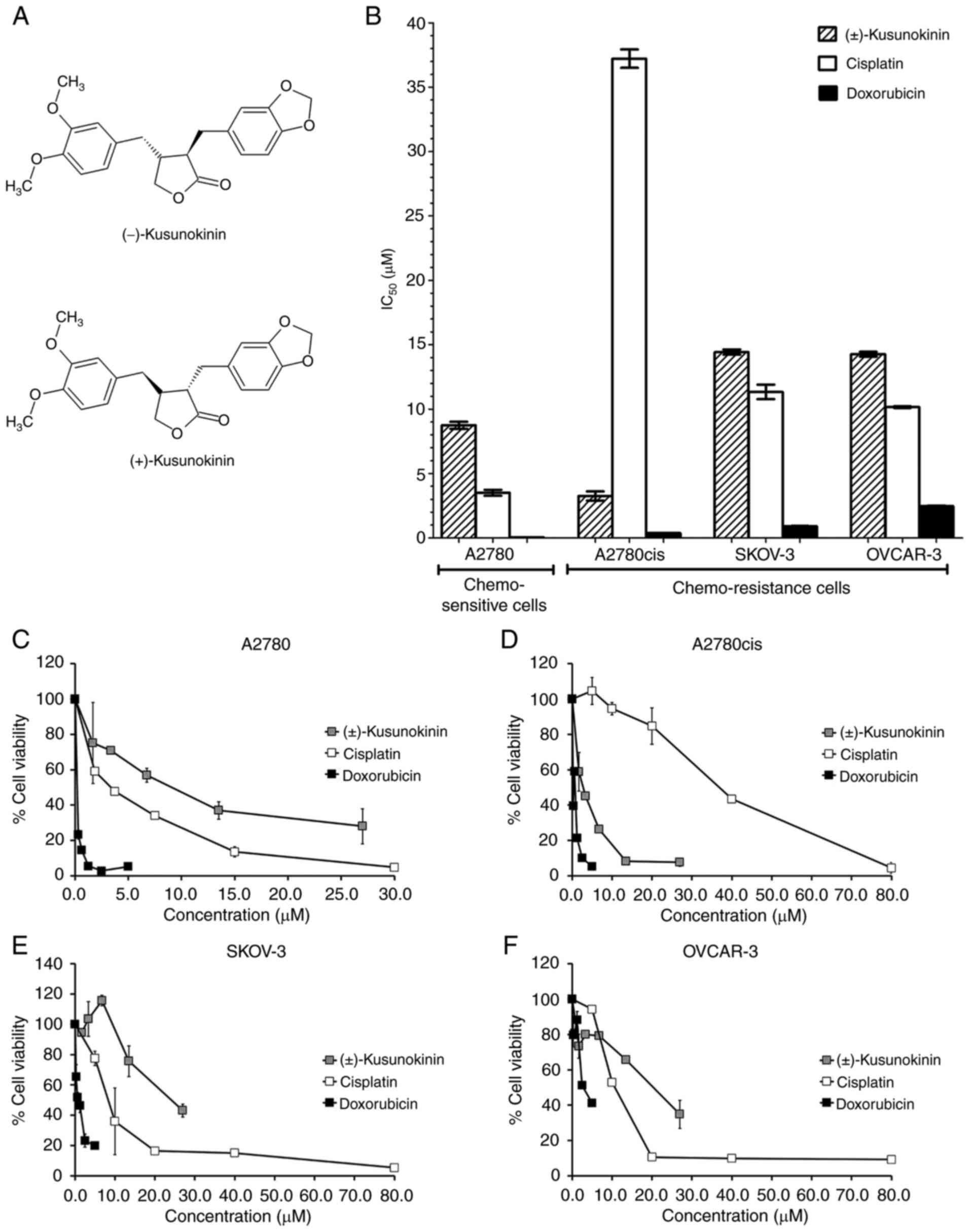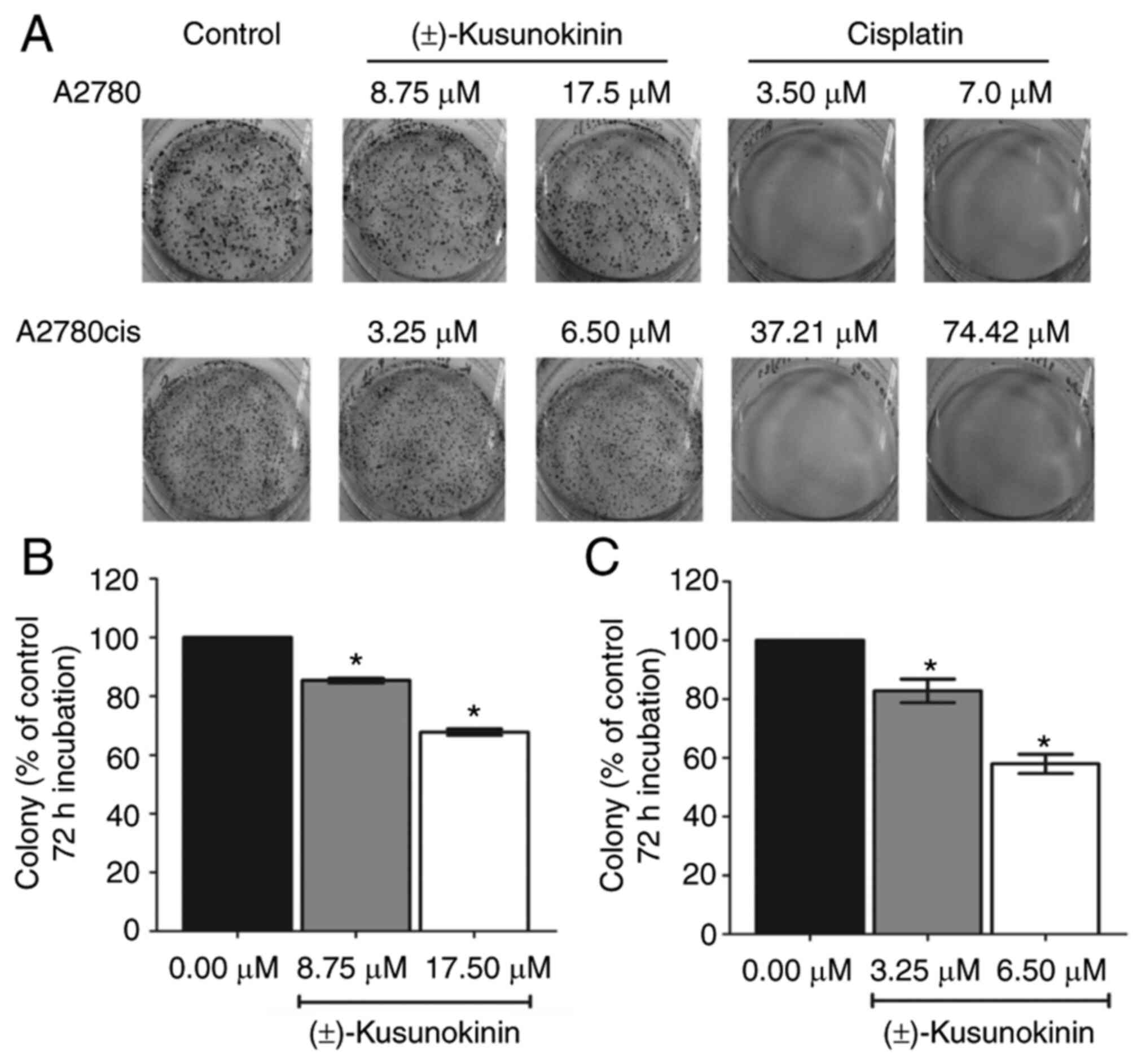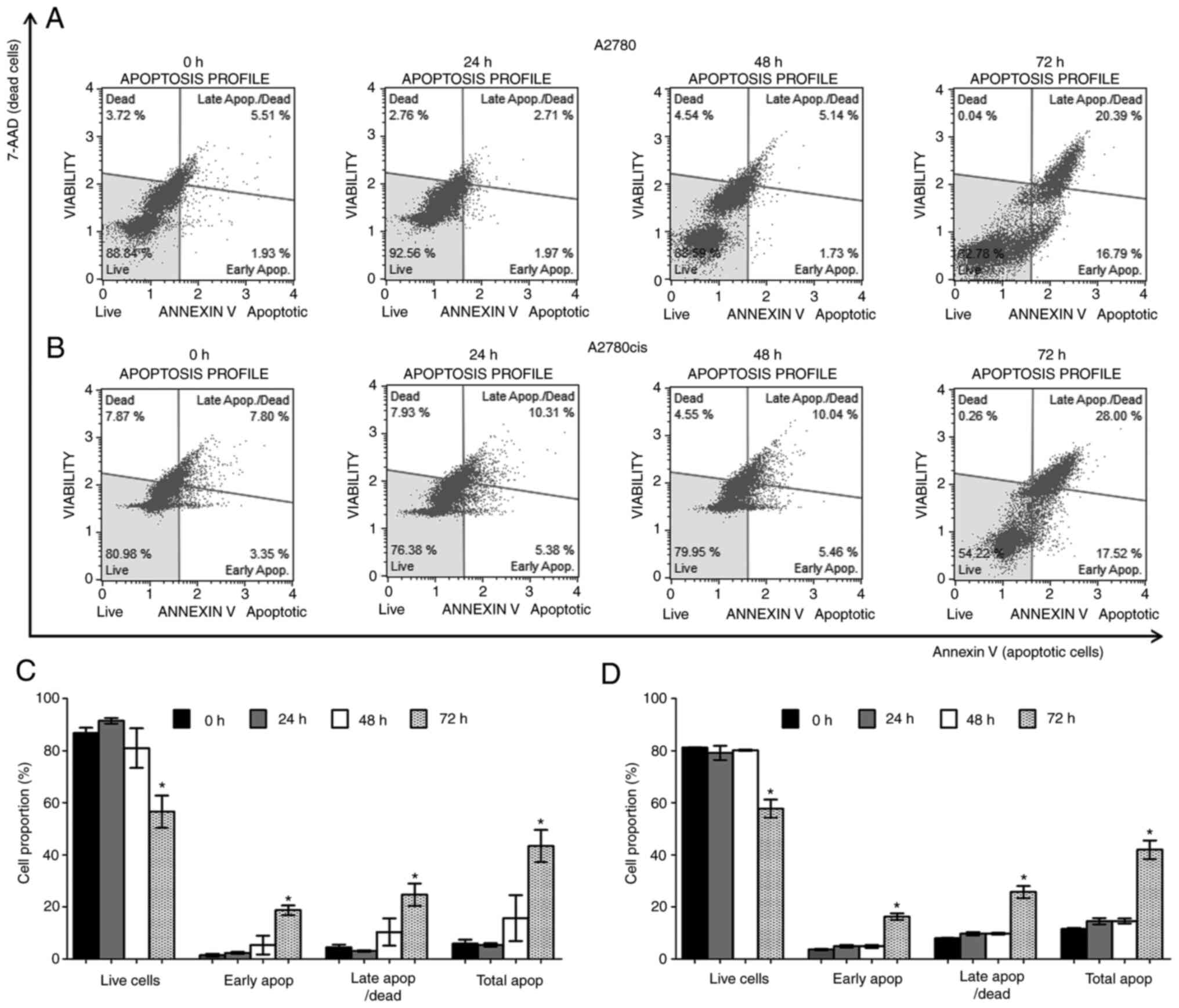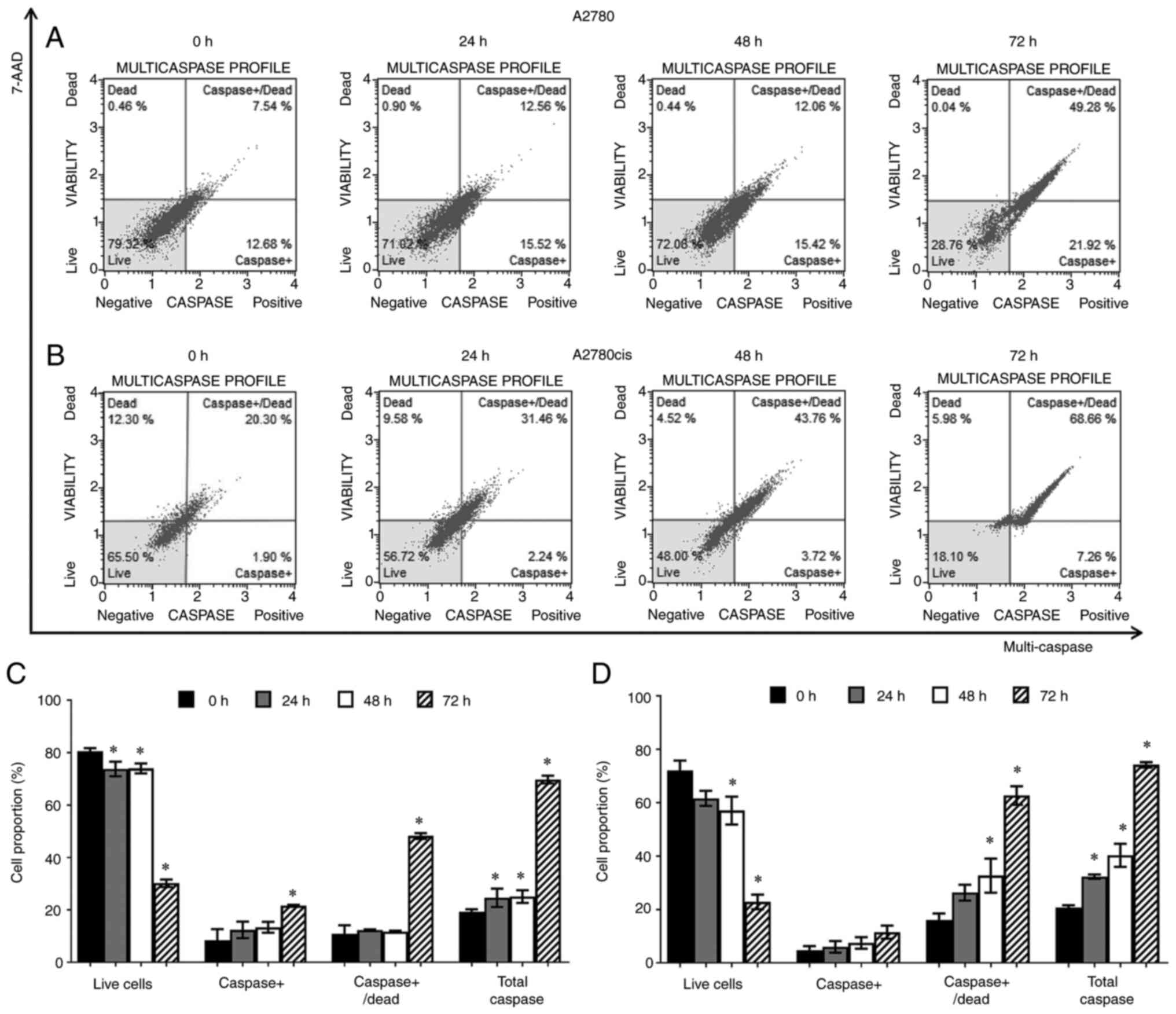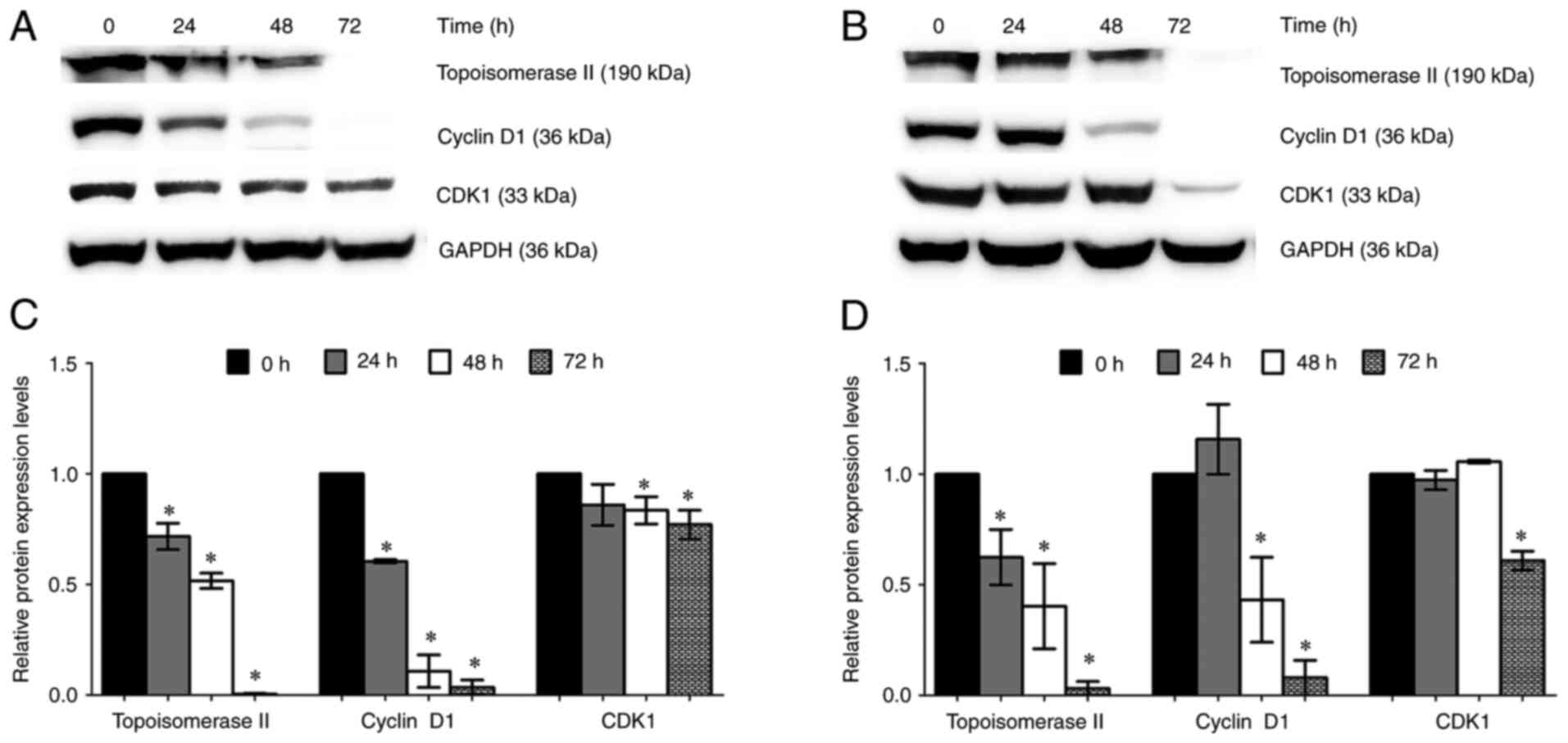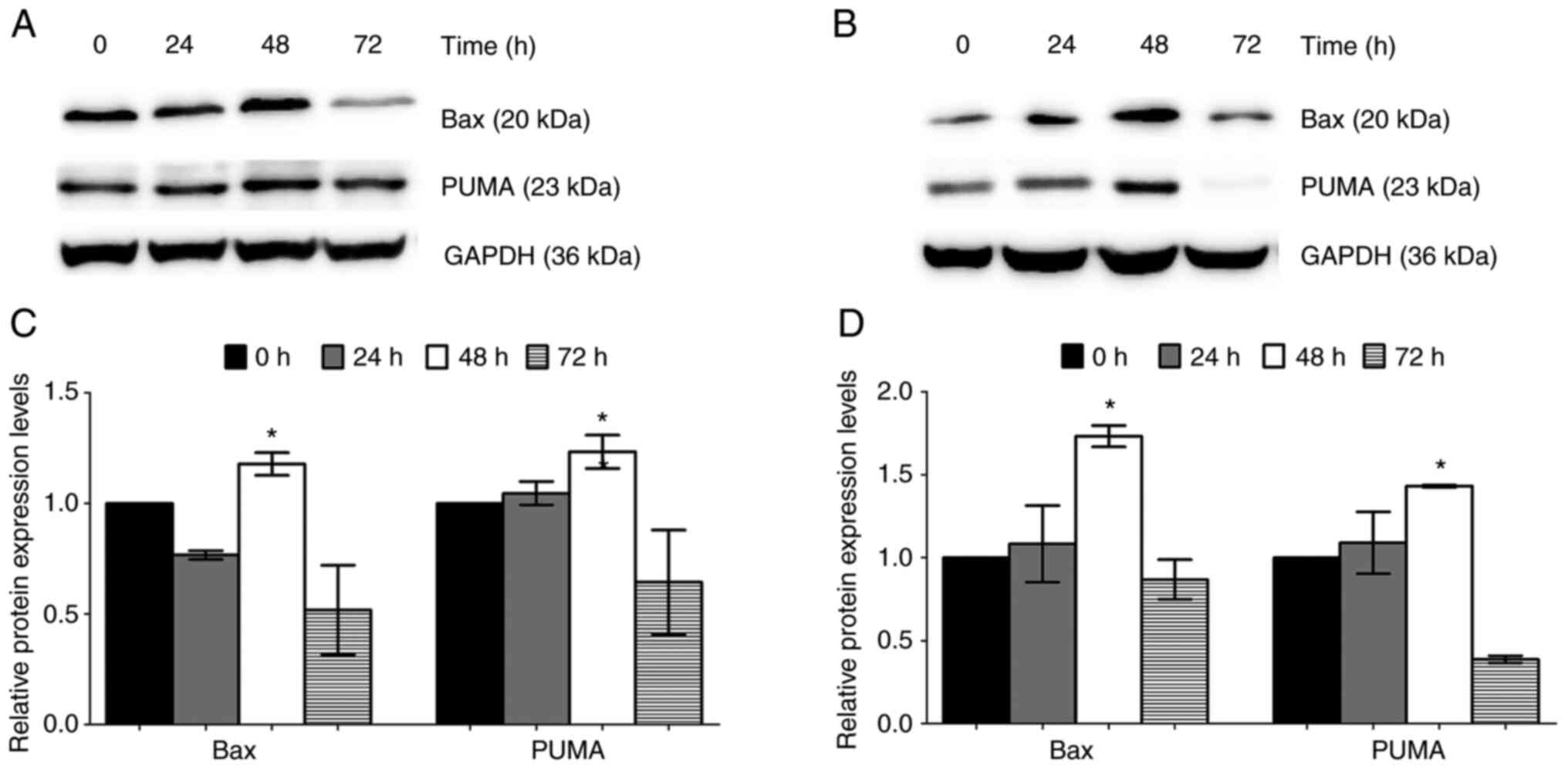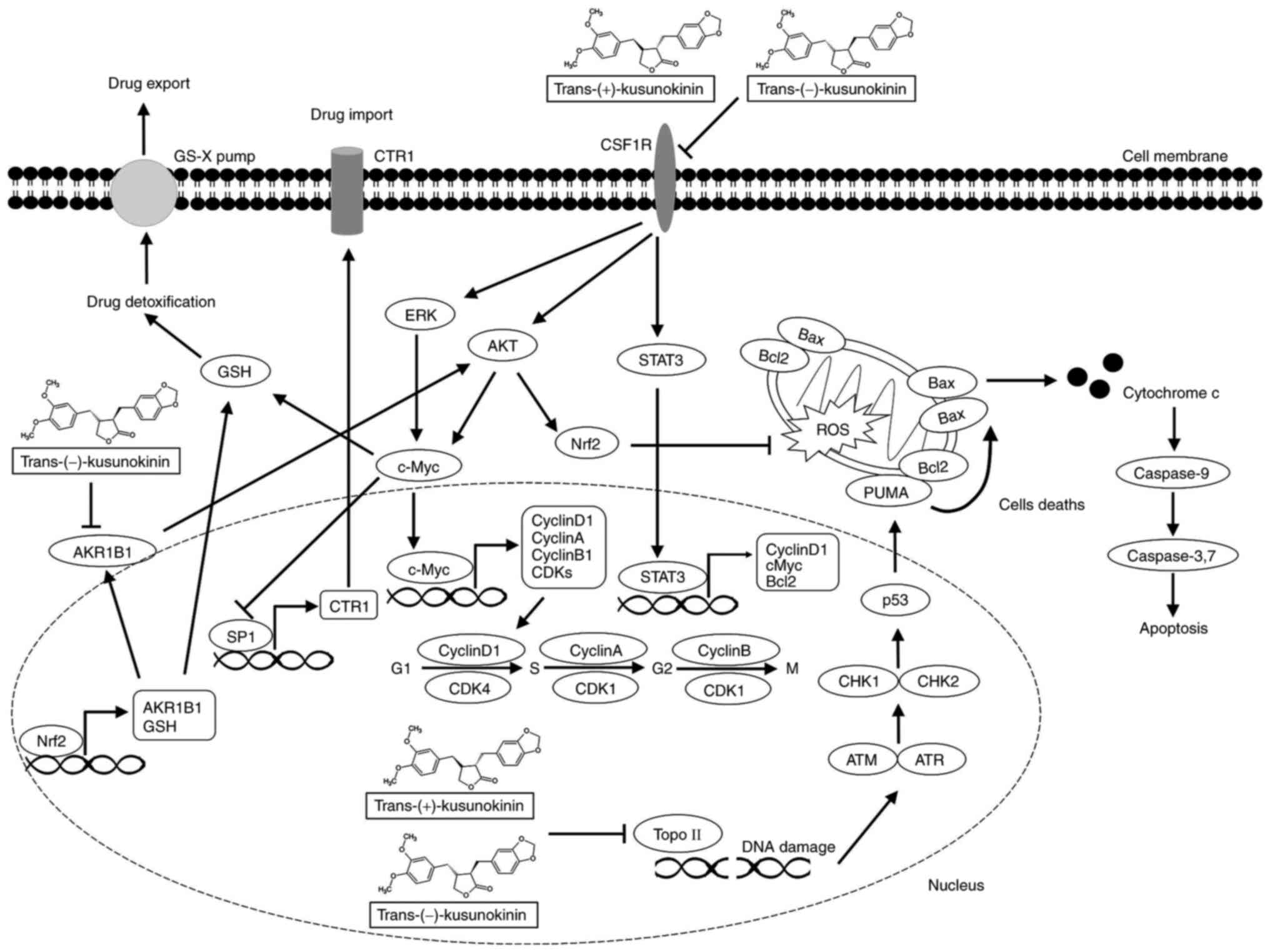|
1
|
Sung H, Ferlay J, Siegel RL, Laversanne M,
Soerjomataram I, Jemal A and Bray F: Global cancer statistics 2020:
GLOBOCAN estimates of incidence and mortality worldwide for 36
cancers in 185 countries. CA Cancer J Clin. 71:209–249. 2021.
View Article : Google Scholar : PubMed/NCBI
|
|
2
|
Reavis HD and Drapkin R: The tubal
epigenome-An emerging target for ovarian cancer. Pharmacol Ther.
210:1075242020. View Article : Google Scholar : PubMed/NCBI
|
|
3
|
Reid BM, Permuth JB and Sellers TA:
Epidemiology of ovarian cancer: A review. Cancer Biol Med. 14:9–32.
2017. View Article : Google Scholar : PubMed/NCBI
|
|
4
|
Kurman RJ and Shih IeM: Molecular
pathogenesis and extraovarian origin of epithelial ovarian
cancer-shifting the paradigm. Hum Pathol. 42:918–931. 2011.
View Article : Google Scholar : PubMed/NCBI
|
|
5
|
Hirst J, Crow J and Godwin A: Ovarian
cancer genetics: Subtypes and risk factors. Ovarian cancer. Pathog
Treat. 1:727052018.
|
|
6
|
Chen X, Wu Y, Dong H, Zhang YC and Zhang
Y: Platinum-based agents for individualized cancer treatment. Curr
Mol Med. 13:1603–1612. 2013. View Article : Google Scholar : PubMed/NCBI
|
|
7
|
Dasari S and Tchounwou PB: Cisplatin in
cancer therapy: Molecular mechanisms of action. Eur J Pharmacol.
740:364–378. 2014. View Article : Google Scholar : PubMed/NCBI
|
|
8
|
van Zyl B, Tang D and Bowden NA:
Biomarkers of platinum resistance in ovarian cancer: What can we
use to improve treatment. Endocr-Relat Cancer. 25:R303–R318. 2018.
View Article : Google Scholar : PubMed/NCBI
|
|
9
|
Oun R, Moussa YE and Wheate NJ:
Correction: The side effects of platinum-based chemotherapy drugs:
A review for chemists. Dalton Trans. 47:78482018. View Article : Google Scholar : PubMed/NCBI
|
|
10
|
Lim HJ and Ledger W: Targeted therapy in
ovarian cancer. Womens Health (Lond). 12:363–378. 2016. View Article : Google Scholar : PubMed/NCBI
|
|
11
|
Padma VV: An overview of targeted cancer
therapy. Biomedicine (Taipei). 4:192015. View Article : Google Scholar : PubMed/NCBI
|
|
12
|
Franzese E, Centonze S, Diana A, Carlino
F, Guerrera LP, Di Napoli M, De Vita F, Pignata S, Ciardiello F and
Orditura M: PARP inhibitors in ovarian cancer. Cancer Treat Rev.
73:1–9. 2019. View Article : Google Scholar : PubMed/NCBI
|
|
13
|
Kristeleit R, Shapiro GI, Burris HA, Oza
AM, LoRusso P, Patel MR, Domchek SM, Balmaña J, Drew Y, Chen LM, et
al: A phase I–II study of the oral PARP inhibitor rucaparib in
patients with germline BRCA1/2-mutated ovarian carcinoma or other
solid tumors. Clin Cancer Res. 23:4095–4106. 2017. View Article : Google Scholar : PubMed/NCBI
|
|
14
|
Zálešák F, Bon DJD and Pospíšil J:
Lignans, Neolignans: Plant secondary metabolites as a reservoir of
biologically active substances. Pharmacol Res. 146:1042842019.
View Article : Google Scholar : PubMed/NCBI
|
|
15
|
Sun J, Wei Q, Zhou Y, Wang J, Liu Q and Xu
H: A systematic analysis of FDA-approved anticancer drugs. BMC Syst
Biol. 11 (Suppl 5):S872017. View Article : Google Scholar : PubMed/NCBI
|
|
16
|
Chuang TC, Hsu SC, Cheng YT, Shao WS, Wu
K, Fang GS, Ou CC and Wang V: Magnolol down-regulates HER2 gene
expression, leading to inhibition of HER2-mediated metastatic
potential in ovarian cancer cells. Cancer Lett. 311:11–19. 2011.
View Article : Google Scholar : PubMed/NCBI
|
|
17
|
Kang K, Nho CW, Kim ND, Song D, Park YG,
Kim M, Pan CH, Shin D, Oh SH and Oh HS: Daurinol, a catalytic
inhibitor of topoisomerase IIα, suppresses SNU-840 ovarian cancer
cell proliferation through cell cycle arrest in S phase. Int J
Oncol. 45:558–566. 2014. View Article : Google Scholar : PubMed/NCBI
|
|
18
|
Lee K, Ahn JH, Lee KT, Jang DS and Choi
JH: Deoxyschizandrin, isolated from Schisandra berries, induces
cell cycle arrest in ovarian cancer cells and inhibits the
protumoural activation of tumour-associated macrophages. Nutrients.
10:912018. View Article : Google Scholar : PubMed/NCBI
|
|
19
|
Huang K, Li LA, Meng YG, You YQ, Fu XY and
Song L: Arctigenin promotes apoptosis in ovarian cancer cells via
the iNOS/NO/STAT3/survivin signaling. Basic Clin Pharmacol Toxicol.
115:507–511. 2014. View Article : Google Scholar : PubMed/NCBI
|
|
20
|
Gözler B, Rentsch D, Gözler T, Ünver N and
Hesse M: Lignans, alkaloids and coumarins from Haplophyllum
vulcanicum. Phytochemistry. 42:695–699. 1996. View Article : Google Scholar
|
|
21
|
Okunishi T, Umezawa T and Shimada M:
Enantiomeric compositions and biosynthesis of Wikstroemia sikokiana
lignans. J Wood Sci. 46:234–242. 2000. View Article : Google Scholar
|
|
22
|
Messiano GB, Vieira L, Machado MB, Lopes
LMX, De Bortoli SA and Zukerman-Schpector J: Evaluation of
insecticidal activity of diterpenes and lignans from Aristolochia
malmeana against Anticarsia gemmatalis. J Agric Food Chem.
56:2655–2659. 2008. View Article : Google Scholar : PubMed/NCBI
|
|
23
|
Sartorelli P, Carvalho CS, Reimao JQ,
Lorenzi H and Tempone AG: Antitrypanosomal activity of a diterpene
and lignans isolated from Aristolochia cymbifera. Planta Med.
76:1454–1456. 2010. View Article : Google Scholar : PubMed/NCBI
|
|
24
|
Kato M, He YM, Dibwe DF, Li F, Awale S,
Kadota S and Tezuka Y: New guaia-type sesquiterpene from
Wikstroemia indica. Nat Prod Commun. 9:1–2. 2014.PubMed/NCBI
|
|
25
|
Morais TR, Costa-Silva TA, Ferreira DD,
Novais BJ, Torrecilhas ACT, Tempone AG and Lago JHG:
Antitrypanosomal activity and effect in plasma membrane
permeability of (−)-bornyl p-coumarate isolated from Piper cernuum
(Piperaceae). Bioorg Chem. 89:1030012019. View Article : Google Scholar : PubMed/NCBI
|
|
26
|
Sriwiriyajan S, Sukpondma Y, Srisawat T,
Madla S and Graidist P: (−)-Kusunokinin and piperloguminine from
Piper nigrum: An alternative option to treat breast cancer. Biomed
Pharmacother. 92:732–743. 2017. View Article : Google Scholar : PubMed/NCBI
|
|
27
|
Niwa AM, de Paula NA, Vesenick DC, Sartori
D, Maistro EL, Ribeiro LR and Mantovani MS: Evaluation of lignan
(−)-cubebin extracted from Piper cubeba on human colon
adenocarcinoma cells (HT29). J Toxicol Environ Health Part A.
79:92–100. 2016. View Article : Google Scholar : PubMed/NCBI
|
|
28
|
Cunha NL, Teixeira GM, Martins TD, Souza
AR, Oliveira PF, Símaro GV, Rezende KC, Gonçalves Ndos S, Souza DG,
Tavares DC, et al: (−)-Hinokinin induces G2/M arrest and
contributes to the antiproliferative effects of doxorubicin in
breast cancer cells. Planta Med. 82:530–538. 2016. View Article : Google Scholar : PubMed/NCBI
|
|
29
|
Tedasen A, Dokduang S, Sukpondma Y,
Lailerd N, Madla S, Sriwiriyajan S, Rattanaburee T, Tipmanee V and
Graidist P: (−)-Kusunokinin inhibits breast cancer in
N-nitrosomethylurea-induced mammary tumor rats. Eur J Pharmacol.
882:1733112020. View Article : Google Scholar : PubMed/NCBI
|
|
30
|
Rattanaburee T, Thongpanchang T, Wongma K,
Tedasen A, Sukpondma Y and Graidist P: Anticancer activity of
synthetic (±)-kusunokinin and its derivative (±)-bursehernin on
human cancer cell lines. Biomed Pharmacother. 117:1091152019.
View Article : Google Scholar : PubMed/NCBI
|
|
31
|
Rattanaburee T, Tipmanee V, Tedasen A,
Thongpanchang T and Graidist P: Inhibition of CSF1R and AKT by
(±)-kusunokinin hinders breast cancer cell proliferation. Biomed
Pharmacother. 129:1103612020. View Article : Google Scholar : PubMed/NCBI
|
|
32
|
Rattanaburee T, Tanawattanasuntorn T,
Thongpanchang T, Tipmanee V and Graidist P: Trans-(−)-Kusunokinin:
A potential anticancer lignan compound against HER2 in breast
cancer cell lines? Molecules. 26:45372021. View Article : Google Scholar : PubMed/NCBI
|
|
33
|
Tanawattanasuntorn T, Thongpanchang T,
Rungrotmongkol T, Hanpaibool C, Graidist P and Tipmanee V:
(−)-Kusunokinin as a potential aldose reductase inhibitor:
Equivalency observed via AKR1B1 dynamics simulation. ACS Omega.
6:606–614. 2021. View Article : Google Scholar : PubMed/NCBI
|
|
34
|
Yu R, Jin H, Jin C, Huang X, Lin J and
Teng Y: Inhibition of the CSF-1 receptor sensitizes ovarian cancer
cells to cisplatin. Cell Biochem Funct. 36:80–87. 2018. View Article : Google Scholar : PubMed/NCBI
|
|
35
|
Sinreih M, Anko M, Kene NH, Kocbek V and
Rižner TL: Expression of AKR1B1, AKR1C3 and other genes of
prostaglandin F2α biosynthesis and action in ovarian endometriosis
tissue and in model cell lines. Chem Biol Interact. 234:320–331.
2015. View Article : Google Scholar : PubMed/NCBI
|
|
36
|
Meden H, Marx D, Roegglen T, Schauer A and
Kuhn W: Overexpression of the oncogene c-erbB-2 (HER2/neu) and
response to chemotherapy in patients with ovarian cancer. Int J
Gynecol Pathol. 17:61–65. 1998. View Article : Google Scholar : PubMed/NCBI
|
|
37
|
Tudrej P, Olbryt M, Zembala-Nożyńska E,
Kujawa KA, Cortez AJ, Fiszer-Kierzkowska A, Pigłowski W, Nikiel B,
Głowala-Kosińska M, Bartkowska-Chrobok A, et al: Establishment and
characterization of the novel high-grade serous ovarian cancer cell
line OVPA8. Int J Mol Sci. 19:20802018. View Article : Google Scholar : PubMed/NCBI
|
|
38
|
Beaufort CM, Helmijr JC, Piskorz AM,
Hoogstraat M, Ruigrok-Ritstier K, Besselink N, Murtaza M, van IJcken
WF, Heine AA, Smid M, et al: Ovarian cancer cell line panel (OCCP):
Clinical importance of in vitro morphological subtypes. PLoS One.
9:e1039882014. View Article : Google Scholar : PubMed/NCBI
|
|
39
|
Sriwiriyajan S, Ninpesh T, Sukpondma Y,
Nasomyon T and Graidist P: Cytotoxicity screening of plants of
genus Piper in breast cancer cell lines. Trop J Pharm Res.
13:921–928. 2014. View Article : Google Scholar
|
|
40
|
Franken NA, Rodermond HM, Stap J, Haveman
J and van Bree C: Clonogenic assay of cells in vitro. Nat Protoc.
1:2315–2319. 2006. View Article : Google Scholar : PubMed/NCBI
|
|
41
|
Hydbring P, Malumbres M and Sicinski P:
Non-canonical functions of cell cycle cyclins and cyclin-dependent
kinases. Nat Rev Mol Cell Biol. 17:280–292. 2016. View Article : Google Scholar : PubMed/NCBI
|
|
42
|
Ali Y and Abd Hamid S: Human topoisomerase
II alpha as a prognostic biomarker in cancer chemotherapy. Tumour
Biol. 37:47–55. 2016. View Article : Google Scholar : PubMed/NCBI
|
|
43
|
Okuda T, Sekizawa A, Purwosunu Y,
Nagatsuka M, Morioka M, Hayashi M and Okai T: Genetics of
endometrial cancers. Obstet Gynecol Int. 2010:9840132010.
View Article : Google Scholar : PubMed/NCBI
|
|
44
|
O'Hara AJ and Bell DW: The genomics and
genetics of endometrial cancer. Adv Genomics Genet. 2012:33–47.
2012.PubMed/NCBI
|
|
45
|
Lee YK, Lim J, Yoon SY, Joo JC, Park SJ
and Park YJ: Promotion of cell death in cisplatin-resistant ovarian
cancer cells through KDM1B-DCLRE1B modulation. Int J Mol Sci.
20:24432019. View Article : Google Scholar : PubMed/NCBI
|
|
46
|
Liu Y, Zhu K, Guan X, Xie S, Wang Y, Tong
Y, Guo L, Zheng H and Lu R: TTK is a potential therapeutic target
for cisplatin-resistant ovarian cancer. J Ovarian Res. 14:1282021.
View Article : Google Scholar : PubMed/NCBI
|
|
47
|
Magherini F, Fiaschi T, Valocchia E,
Becatti M, Pratesi A, Marzo T, Massai L, Gabbiani C, Landini I,
Nobili S, et al: Antiproliferative effects of two
gold(I)-N-heterocyclic carbene complexes in A2780 human ovarian
cancer cells: A comparative proteomic study. Oncotarget.
9:28042–28068. 2018. View Article : Google Scholar : PubMed/NCBI
|
|
48
|
Mortensen ACL, Mohajershojai T, Hariri M,
Pettersson M and Spiegelberg D: Overcoming limitations of cisplatin
therapy by additional treatment with the HSP90 inhibitor onalespib.
Front Oncol. 10:5322852020. View Article : Google Scholar : PubMed/NCBI
|
|
49
|
Gorini G, Magherini F, Fiaschi T, Massai
L, Becatti M, Modesti A, Messori L and Gamberi T:
Au2phen and Auoxo6, two dinuclear oxo-bridged gold (III)
compounds, induce apoptotic signaling in human ovarian A2780 cancer
cells. Biomedicines. 9:8712021. View Article : Google Scholar : PubMed/NCBI
|
|
50
|
Chen SH and Chang JY: New insights into
mechanisms of cisplatin resistance: From tumor cell to
microenvironment. Int J Mol Sci. 20:41362019. View Article : Google Scholar : PubMed/NCBI
|
|
51
|
Chen SJ, Kuo CC, Pan HY, Tsou TC, Yeh SC
and Chang JY: Desferal regulates hCtr1 and transferrin receptor
expression through Sp1 and exhibits synergistic cytotoxicity with
platinum drugs in oxaliplatin-resistant human cervical cancer cells
in vitro and in vivo. Oncotarget. 7:49310–49321. 2016. View Article : Google Scholar : PubMed/NCBI
|
|
52
|
Liang ZD, Long Y, Chen HH, Savaraj N and
Kuo MT: Regulation of the high-affinity copper transporter (hCtr1)
expression by cisplatin and heavy metals. J Biol Inorg Chem.
19:17–27. 2014. View Article : Google Scholar : PubMed/NCBI
|
|
53
|
Reyes-González JM and Vivas-Mejía PE:
c-MYC and epithelial ovarian cancer. Front Oncol. 11:6015122021.
View Article : Google Scholar : PubMed/NCBI
|
|
54
|
Benassi B, Fanciulli M, Fiorentino F,
Porrello A, Chiorino G, Loda M, Zupi G and Biroccio A: c-Myc
phosphorylation is required for cellular response to oxidative
stress. Mol Cell. 21:509–519. 2006. View Article : Google Scholar : PubMed/NCBI
|
|
55
|
Sun CY, Nie J, Huang JP, Zheng GJ and Feng
B: Targeting STAT3 inhibition to reverse cisplatin resistance.
Biomed Pharmacother. 117:1091352019. View Article : Google Scholar : PubMed/NCBI
|
|
56
|
Chen WD and Zhang Y: Regulation of
aldo-keto reductases in human diseases. Front Pharmacol. 3:352012.
View Article : Google Scholar : PubMed/NCBI
|
|
57
|
Kutikhin AG, Yuzhalin AE, Tsitko EA and
Brusina EB: Pattern recognition receptors and DNA repair: Starting
to put a jigsaw puzzle together. Front Immunol. 5:3432014.
View Article : Google Scholar : PubMed/NCBI
|
|
58
|
Wang L, Zhao X, Fu J, Xu W and Yuan J: The
role of tumour metabolism in cisplatin resistance. Front Mol
Biosci. 8:6917952021. View Article : Google Scholar : PubMed/NCBI
|
|
59
|
Mirzaei S, Zarrabi A, Hashemi F, Zabolian
A, Saleki H, Azami N, Hamzehlou S, Farahani MV, Hushmandi K,
Ashrafizadeh M, et al: Nrf2 signaling pathway in chemoprotection
and doxorubicin resistance: Potential application in drug
discovery. Antioxidants (Basel). 10:3492021. View Article : Google Scholar : PubMed/NCBI
|
|
60
|
Liu Y, Liu P, Wang Q, Sun F and Liu F:
Sulforaphane attenuates H2O2-induced oxidant
stress in human trabecular meshwork cells (HTMCs) via the
phosphatidylinositol 3-kinase (PI3K)/serine/threonine kinase
(Akt)-mediated factor-E2-related factor 2 (Nrf2) signaling
activation. Med Sci Monit. 25:811–818. 2019. View Article : Google Scholar : PubMed/NCBI
|
|
61
|
Achkova D and Maher J: Role of the
colony-stimulating factor (CSF)/CSF-1 receptor axis in cancer.
Biochem Soc Trans. 44:333–341. 2016. View Article : Google Scholar : PubMed/NCBI
|
|
62
|
García-Gutiérrez L, Delgado MD and León J:
MYC Oncogene contributions to release of cell cycle brakes. Genes
(Basel). 10:2442019. View Article : Google Scholar : PubMed/NCBI
|
|
63
|
Reyes-González JM, Armaiz-Peña GN, Mangala
LS, Valiyeva F, Ivan C, Pradeep S, Echevarría-Vargas IM,
Rivera-Reyes A, Sood AK and Vivas-Mejía PE: Targeting c-MYC in
platinum-resistant ovarian cancer. Mol Cancer Ther. 14:2260–2269.
2015. View Article : Google Scholar : PubMed/NCBI
|
|
64
|
Liang F, Ren C, Wang J, Wang S, Yang L,
Han X, Chen Y, Tong G and Yang G: The crosstalk between STAT3 and
p53/RAS signaling controls cancer cell metastasis and cisplatin
resistance via the Slug/MAPK/PI3K/AKT-mediated regulation of EMT
and autophagy. Oncogenesis. 8:592019. View Article : Google Scholar : PubMed/NCBI
|
|
65
|
Veskimäe K, Scaravilli M, Niininen W,
Karvonen H, Jaatinen S, Nykter M, Visakorpi T, Mäenpää J, Ungureanu
D and Staff S: Expression analysis of platinum sensitive and
resistant epithelial ovarian cancer patient samples reveals new
candidates for targeted therapies. Transl Oncol. 11:1160–1170.
2018. View Article : Google Scholar : PubMed/NCBI
|
|
66
|
Furtek SL, Backos DS, Matheson CJ and
Reigan P: Strategies and approaches of targeting STAT3 for cancer
treatment. ACS Chem Biol. 11:308–318. 2016. View Article : Google Scholar : PubMed/NCBI
|
|
67
|
Yuan Z, Cao K, Lin C, Li L, Liu HY, Zhao
XY, Liu L, Deng HX, Li J, Nie CL and Wei YQ: The p53 upregulated
modulator of apoptosis (PUMA) chemosensitizes intrinsically
resistant ovarian cancer cells to cisplatin by lowering the
threshold set by Bcl-x(L) and Mcl-1. Mol Med. 17:1262–1274. 2011.
View Article : Google Scholar : PubMed/NCBI
|
|
68
|
Atkin ND, Raimer HM and Wang YH: Broken by
the cut: A journey into the role of topoisomerase II in DNA
fragility. Genes (Basel). 10:7912019. View Article : Google Scholar : PubMed/NCBI
|
|
69
|
Turnell AS and Grand RJ: DNA viruses and
the cellular DNA-damage response. J Gen Virol. 93((Pt 10)):
2076–2097. 2012. View Article : Google Scholar : PubMed/NCBI
|
|
70
|
Strasser A, Cory S and Adams JM:
Deciphering the rules of programmed cell death to improve therapy
of cancer and other diseases. EMBO J. 30:3667–3683. 2011.
View Article : Google Scholar : PubMed/NCBI
|
|
71
|
Tait SW and Green DR: Mitochondrial
regulation of cell death. Cold Spring Harb Perspect Biol.
5:a0087062013. View Article : Google Scholar : PubMed/NCBI
|
|
72
|
Skok Ž, Zidar N, Kikelj D and Ilaš J: Dual
inhibitors of human DNA topoisomerase II and other cancer-related
targets. J Med Chem. 63:884–904. 2020. View Article : Google Scholar : PubMed/NCBI
|
|
73
|
Hu W, Wang F, Tang J, Liu X, Yuan Z, Nie C
and Wei Y: Proapoptotic protein Smac mediates apoptosis in
cisplatin-resistant ovarian cancer cells when treated with the
anti-tumor agent AT101. J Biol Chem. 287:68–80. 2012. View Article : Google Scholar : PubMed/NCBI
|
|
74
|
Hahne JC, Honig A, Meyer SR, Gambaryan S,
Walter U, Wischhusen J, Häussler SF, Segerer SE, Fujita N, Dietl J
and Engel JB: Downregulation of AKT reverses platinum resistance of
human ovarian cancers in vitro. Oncol Rep. 28:2023–2028. 2012.
View Article : Google Scholar : PubMed/NCBI
|
|
75
|
Noel EE, Yeste-Velasco M, Mao X, Perry J,
Kudahetti SC, Li NF, Sharp S, Chaplin T, Xue L, McIntyre A, et al:
The association of CCND1 overexpression and cisplatin resistance in
testicular germ cell tumors and other cancers. Am J Pathol.
176:2607–2615. 2010. View Article : Google Scholar : PubMed/NCBI
|
|
76
|
Kielbik M, Krzyzanowski D, Pawlik B and
Klink M: Cisplatin-induced ERK1/2 activity promotes G1 to S phase
progression which leads to chemoresistance of ovarian cancer cells.
Oncotarget. 9:19847–19860. 2018. View Article : Google Scholar : PubMed/NCBI
|















